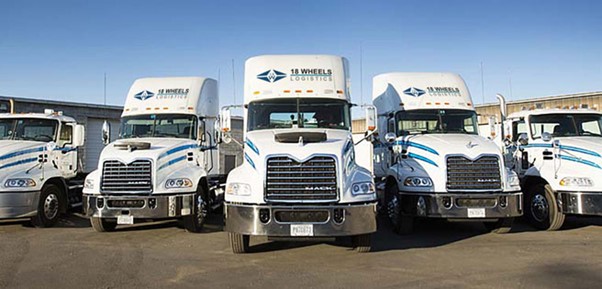Michael Yevgen Kotendzhi is the COO and a Partner with 18 Wheels Logistics, a Vancouver BC based transportation and warehousing company. As President of Operations & Transportation for the company, Mr. Kotendzhi understands the need to continually evolve the technology associated with 3PL and related industries. In the article below Michael Kotendzhi discusses the role of automation in warehousing.
To stay ahead of the competition, Michael Kotendzhi explains that warehouses constantly update their automated processes to speed up operations and e-commerce. Some of the latest advances include using robots to pick and pack orders, switching to automated management systems, and implementing predictive analytics. By automating their operations, warehouses can fulfill customers’ orders more accurately and ship their products faster.
Michael Kotendzhi takes a closer look at some of the latest automation trends and explore how warehouses manage to implement new technologies to streamline their operations. We’ll discuss the importance of automation and share a few ways that technology has allowed warehouses to reduce costs, boost efficiency, and improve customer experience.
Robots, Drones, and Automated Lifts
Michael Yevgen Kotendzhi explains that robots are increasingly being used in warehouses to pick and pack orders. They can quickly and accurately move around the warehouse, grabbing items from shelves and loading them into boxes. As warehouses progressively shift towards this type of robotic automation, they’ll eventually eliminate the need for long conveyor belts.
Currently, Michael Kotendzhi says warehouses around the United States are programming their forklifts to automatically navigate and process orders. Others have started to use drones to collect and transport smaller objects throughout the warehouse.
Thanks to their ever-increasing speed and efficiency, Michael Kotendzhi says that robots, drones, and other automated equipment are becoming more and more common across the industry. These technologies can help to reduce labor costs and improve safety by reducing the need for human workers to perform dangerous tasks.
Automated Management Systems
Michael Kotendzhi reports that many warehouses have switched to automated management systems, which track inventory and orders using barcodes and RFID tags. These systems help warehouses keep track of their inventory levels and ensure that orders are filled correctly. They can also help managers plan and optimize warehouse operations.
Some of the benefits of implementing these automated management systems include:
- Reduced labor costs – Automated systems can reduce the need for manual labor by tracking items using RFID tags. These small devices are attached to shipments objects and then wirelessly transmit data that can be tacked from anywhere in the warehouse.
- Increased accuracy – Automated systems can help reduce errors in inventory management and order fulfillment by reducing the amount of manual involvement, according to Michael Yevgen Kotendzhi.
- Improved efficiency – Automated systems can help managers optimize warehouse efficiency by maximizing space and reducing the cost of pricey errors.
The only downside to using automated management systems is the high initial investment cost. Although the total cost of a system depends on its features and the size of the warehouse it’s meant to manage, high-quality systems can cost several thousands of dollars.
 Predictive Analytics
Predictive Analytics
Lately, Michael Kotendzhi says many warehouses have started using predictive analytics to predict customer demand and plan production accordingly. This helps warehouses avoid overstocking or running out of inventory, as well as identifying trends and optimizing warehouse operations.
Predictive analytics uses historical data to
predict future trends. It takes into account various factors, such as customer behavior, weather, seasonality, and economic trends. This information is then used to develop a model that can predict future demand.
This model can be used to make decisions about production, inventory, and other warehouse operations. For example, if the model predicts that demand will increase in the future, the warehouse may decide to increase production or stock more inventory. Alternatively, if the model predicts that demand will decrease, the warehouse may decide to decrease production or reduce inventory levels.
Predictive analytics can be used to improve many aspects of warehouse operations, from inventory management to picking and packing according to Michael Kotendzhi. It can also be used to optimize the layout of the warehouse and improve order-fulfillment rates.
Why These Processes Matter
Warehouses are the backbone of the commodities market. Without them, we’d have to directly purchase goods from manufacturers, making it harder to buy items produced outside our local region. Unfortunately, though, warehouses do add to the cost of production. By automating warehouse systems, though, warehouse managers can cut costs and pass those savings on to the consumer.
In addition, Michael Yevgen Kotendzhi says automating warehouse processes can help to improve accuracy and efficiency. This directly benefits the consumer by ensuring that the right products are delivered to the right people at the right time. Consumers can also easily track orders and get information about their products whenever they need it.
Final Thoughts
As you can see, there are many automated processes that warehouses use to improve their operations. Michael Kotendzhi explains these processes help reduce labor costs, improve accuracy, and boost efficiency. In some cases, they can also help to improve customer experience. Overall, the goal of automation is to help warehouses operate more effectively and efficiently, thereby improving their bottom line and better competing in the marketplace.
